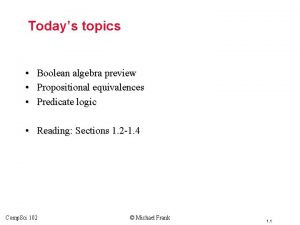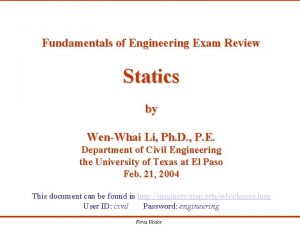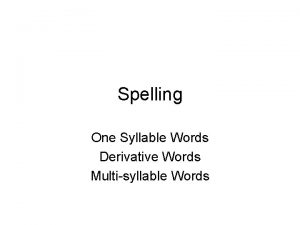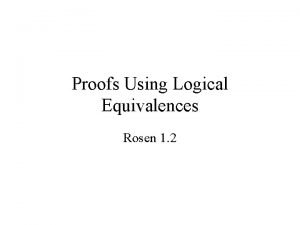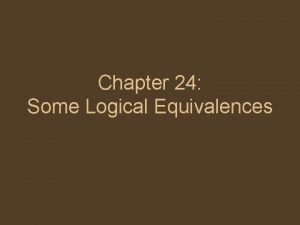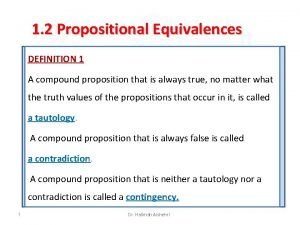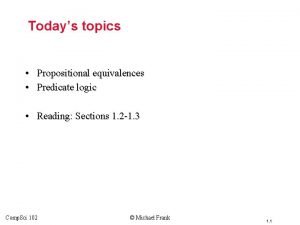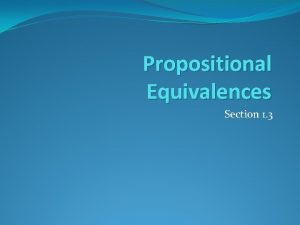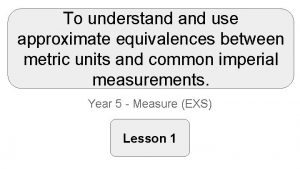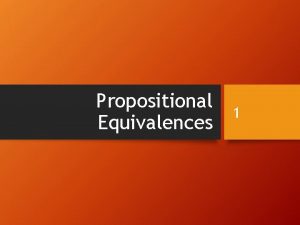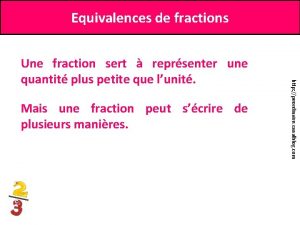Final Review List of Logical Equivalences p T















































- Slides: 47

Final Review

List of Logical Equivalences p T p; p F p Identity Laws p T T; p F F Domination Laws p p p; p p p Idempotent Laws ( p) p Double Negation Law p q q p; p q q p Commutative Laws (p q) r p (q r); (p q) r p (q r) Associative Laws

List of Equivalences p (q r) (p q) (p r) Distribution Laws (p q) ( p q) De Morgan’s Laws p p T p p F (p q) ( p q) Miscellaneous Or Tautology And Contradiction Implication Equivalence p q (p q) (q p) Biconditional Equivalence

The Proof Process Assumptions Logical Steps -Definitions -Already-proved equivalences -Statements (e. g. , arithmetic or algebraic) Conclusion (That which was to be proved)

Prove: (p q) q p q (p q) q q (p q) (q p) (q q) (q p) T q p p q Left-Hand Statement Commutative Distributive Or Tautology Identity Commutative Begin with exactly the left-hand side statement End with exactly what is on the right Justify EVERY step with a logical equivalence

Predicate Calculus: Quantifiers Universe of Discourse, U: The domain of a variable in a propositional function. Universal Quantification of P(x) is the proposition: “P(x) is true for all values of x in U. ” Existential Quantification of P(x) is the proposition: “There exists an element, x, in U such that P(x) is true. ”

Universal Quantification of P(x) x. P(x) “for all x P(x)” “for every x P(x)” Defined as: P(x 0) P(x 1) P(x 2) P(x 3) . . . for all xi in U Example: Let P(x) denote x 2 x If U is x such that 0 < x < 1 then x. P(x) is false. If U is x such that 1 < x then x. P(x) is true.

Existential Quantification of P(x) x. P(x) “there is an x such that P(x)” “there is at least one x such that P(x)” “there exists at least one x such that P(x)” Defined as: P(x 0) P(x 1) P(x 2) P(x 3) . . . for all xi in U Example: Let P(x) denote x 2 x If U is x such that 0 < x 1 then x. P(x) is true. If U is x such that x < 1 then x. P(x) is true.

Quantifiers x. P(x) • True when P(x) is true for every x. • False if there is an x for which P(x) is false. x. P(x) • True if there exists an x for which P(x) is true. • False if P(x) is false for every x.

Negation (it is not the case) x. P(x) equivalent to x P(x) • True when P(x) is false for every x • False if there is an x for which P(x) is true. x. P(x) is equivalent to x P(x) • True if there exists an x for which P(x) is false. • False if P(x) is true for every x.

Examples 2 a Let T(a, b) denote the propositional function “a trusts b. ” Let U be the set of all people in the world. Everybody trusts Bob. x. T(x, Bob) Could also say: x U T(x, Bob) denotes membership Bob trusts somebody. x. T(Bob, x)

Examples 2 b Alice trusts herself. T(Alice, Alice) Alice trusts nobody. x T(Alice, x) Carol trusts everyone trusted by David. x(T(David, x) T(Carol, x)) Everyone trusts somebody. x y T(x, y)

Quantification of Two Variables (read left to right) x y. P(x, y) or y x. P(x, y) • True when P(x, y) is true for every pair x, y. • False if there is a pair x, y for which P(x, y) is false. x y. P(x, y) or y x. P(x, y) True if there is a pair x, y for which P(x, y) is true. False if P(x, y) is false for every pair x, y.

Quantification of Two Variables x y. P(x, y) • True when for every x there is a y for which P(x, y) is true. (in this case y can depend on x) • False if there is an x such that P(x, y) is false for every y. y x. P(x, y) • True if there is a y for which P(x, y) is true for every x. (i. e. , true for a particular y regardless (or independent) of x) • False if for every y there is an x for which P(x, y) is false. Note that order matters here In particular, if y x. P(x, y) is true, then x y. P(x, y) is true. However, if x y. P(x, y) is true, it is not necessary that y x. P(x, y) is true.

Examples 3 a Let L(x, y) be the statement “x loves y” where U for both x and y is the set of all people in the world. Everybody loves Jerry. x. L(x, Jerry) Everybody loves somebody. x y. L(x, y) There is somebody whom everybody loves. y x. L(x, y)

Examples 3 b 1 There is somebody whom Lydia does not love. x L(Lydia, x) Nobody loves everybody. (For each person there is at least one person they do not love. ) x y L(x, y) There is somebody (one or more) whom nobody loves y x L(x, y)

Basic Number Theory Definitions • • • from Chapter 2 Z = Set of all Integers Z+ = Set of all Positive Integers N = Set of Natural Numbers (Z+ and Zero) R = Set of Real Numbers Addition and multiplication on integers produce integers. (a, b Z) [(a+b) Z] [(ab) Z]

Number Theory Defs (cont. ) • • • = “such that” n is even is defined as k Z n = 2 k n is odd is defined as k Z n = 2 k+1 x is rational is defined as a, b Z x = a/b, b 0 x is irrational is defined as a, b Z x = a/b, b 0 or a, b Z, x a/b, b 0 p Z+ is prime means that the only positive factors of p are p and 1. If p is not prime we say it is composite.

Methods of Proof p q (Example: if n is even, then n 2 is even) • Direct proof: Assume p is true and use a series of previously proven statements to show that q is true. • Indirect proof: Show q p is true (contrapositive), using any proof technique (usually direct proof). • Proof by contradiction: Assume negation of what you are trying to prove (p q). Show that this leads to a contradiction.

Example of an Indirect Proof Prove: If n 3 is even, then n is even. Proof: The contrapositive of “If n 3 is even, then n is even” is “If n is odd, then n 3 is odd. ” If the contrapositive is true then the original statement must be true. Assume n is odd. Then k Z n = 2 k+1. It follows that n 3 = (2 k+1)3 = 8 k 3+8 k 2+4 k+1 = 2(4 k 3+4 k 2+2 k)+1. (4 k 3+4 k 2+2 k) is an integer. Therefore n 3 is 1 plus an even integer. Therefore n 3 is odd. Assumption, Definition, Arithmetic, Conclusion

Example: Proof by Contradiction Prove: The sum of an irrational number and a rational number is irrational. Proof: Let q be an irrational number and r be a rational number. Assume that their sum is rational, i. e. , q+r=s where s is a rational number. Then q = s-r. But by our previous proof the sum of two rational numbers must be rational, so we have an irrational number on the left equal to a rational number on the right. This is a contradiction. Therefore q+r can’t be rational and must be irrational.

Structure of Proof by Contradiction • Basic idea is to assume that the opposite of what you are trying to prove is true and show that it results in a violation of one of your initial assumptions. • In the previous proof we showed that assuming that the sum of a rational number and an irrational number is rational and showed that it resulted in the impossible conclusion that a number could be rational and irrational at the same time. (It can be put in a form that implies n n is true, which is a contradiction. )

Approaches to Set Proofs • Membership tables (similar to truth tables) • Convert to a problem in propositional logic, prove, then convert back • Use set identities for a tabular proof (similar to what we did for the propositional logic examples but using set identities) • Do a logical argument (similar to what we did for the number theory examples)

Prove (A B) = B (A B) = {x | x (A B)} Set builder notation = {x | x (A B)} Def of = {x | (x A x B)} Def of x 2 and Def of complement = {x | (x B x A )} Commutative x 2 = {x | (x B (x A )} Distributive = {x | (x B T } Or tautology = {x | (x B } Identity =B Set Builder notation

Prove (A B) = B (Using Set Identities) (A B) = (B A) =B (A A) =B U =B Commutative Law x 2 Distributive Law Definition of U Identity Law

Prove (A B) = B Proof: We must show that (A B) B and that B (A B). First we will show that (A B) B. Let e be an arbitrary element of (A B). Then either e (A B) or e (A B). If e (A B), then e B and e A. In either case e B.

Prove (A B) = B Now we will show that B (A B). Let e be an arbitrary element of B. Then either e A B or e A B. Since e is in one or the other, then e (A B).

Functions: One-to-one function A function f is said to be one-toone, or injective, if and only if f(x) = f(y) implies that x=y for all x and y in the domain of f. f a 1 a 2 A f f a 1 a 2 f a 3 One-to-one? A f b 4 One-to-one? b 1 b 2 B b 3 a 0, a 1 A f(a 0) = f(a 1) a 0 = a 1 OR a 0 a 1 f(a 0) f(a 1) b 1 b 2 b 3 B

Onto Function A function f from A to B is called onto, or surjective, if and only if for every element b B there a 2 is an element a A with f(a) = b. f f a 1 f a 3 A f a 1 a 2 f a 3 b 1 b 2 A b B a A such that f(a) = b f b 1 b 2 B b 3 B

One-to-one Correspondence The function f is a one-to-one correspondence or a bijection, if it is both one-toone and onto. f f a 1 a 2 f a 3 A f a 1 a 2 f a 3 Bijection? A Bijection? b 1 b 2 B f b 1 b 2 B b 3

Correspondence Diagrams: Oneto-One or Onto? a b c d 1 2 3 4 One-to-one, not onto a b c d 1 2 3 4 Neither one-to-one nor onto 1 2 3 Onto, not one-to-one a b c Not a function! a b c d One-to-one, and onto 1 2 3 4

Inverse Function, f-1 Let f be a one-to-one correspondence from the set A to the set B. The inverse function of f is the function that assigns to an element b belonging to B the unique element a in A such that if f(a) = b, then f-1(b) = a. Example: f b a f(a) = 3(a-1) f-1(b) = (b/3)+1 f-1

Examples Is each of the following (on the real numbers): a function? one-to-one? Onto? Invertible? f(x) = 1/x not a function f(0) undefined f(x) = x not a function since not defined for x<0 f(x) = x 2 is a function, not 1 -to-1 (-2, 2 both go to 4), not onto since no way to get to the negative numbers, not invertible

Sequence • A sequence is a discrete structure used to represent an ordered list. • A sequence is a function from a subset of the set of integers (usually either the set {0, 1, 2, . . . } or {1, 2, 3, . . . }to a set S. • We use the notation an to denote the image of the integer n. We call an a term of the sequence. • Notation to represent sequence is {an}

Examples • {1, 1/2, 1/3, 1/4, . . . } or the sequence {an} where an = 1/n, n Z+. • {1, 2, 4, 8, 16, . . . } = {an} where an = 2 n, n N. • {12, 22, 32, 42, . . . } = {an} where an = n 2, n Z+

Summations • Notation for describing the sum of the terms am+1, . . . , an from the sequence, {an} a m, n am+am+1+. . . + an = aj j=m • j is the index of summation (dummy variable) • The index of summation runs through all integers from its lower limit, m, to its upper limit, n.

Summations follow all the rules of multiplication and addition! c(1+2+…+n) = c + 2 c +…+ nc

Telescoping Sums Example

Closed Form Solutions A simple formula that can be used to calculate a sum without doing all the additions. Example: Proof: First we note that k 2 - (k-1)2 = k 2 - (k 2 -2 k+1) = 2 k-1. Since k 2 -(k-1)2 = 2 k-1, then we can sum each side from k=1 to k=n

Proof (cont. )

Big-O Notation • Let f and g be functions from the set of integers or the set of real numbers to the set of real numbers. We say that f(x) is O(g(x)) if there are constants C N and k R such that |f(x)| C|g(x)| whenever x > k. • We say “f(x) is big-oh of g(x)”. • The intuitive meaning is that as x gets large, the values of f(x) are no larger than a constant time the values of g(x), or f(x) is growing no faster than g(x). • The supposition is that x gets large, it will approach a simplified limit.

Show that 3 2 3 x +2 x +7 x+9 is O(x 3) Proof: We must show that constants C N and k R such that |3 x 3+2 x 2+7 x+9| C|x 3| whenever x > k. Choose k = 1 then 3 x 3+2 x 2+7 x+9 3 x 3+2 x 3+7 x 3+9 x 3 = 21 x 3 So let C = 21. Then 3 x 3+2 x 2+7 x+9 21 x 3 when x 1.

Show that n! is O(nn) Proof: We must show that constants C N and k R such that |n!| C|nn| whenever n > k. n! = n(n-1)(n-2)(n-3)…(3)(2)(1) n(n)(n)(n)…(n)(n)(n) n times =nn So choose k = 0 and C = 1

General Rules • Multiplication by a constant does not change the rate of growth. If f(n) = kg(n) where k is a constant, then f is O(g) and g is O(f). • The above means that there an infinite number of pairs C, k that satisfy the Big-O definition. • Addition of smaller terms does not change the rate of growth. If f(n) = g(n) + smaller order terms, then f is O(g) and g is O(f). Ex. : f(n) = 4 n 6 + 3 n 5 + 100 n 2 + 2 is O(n 6).

General Rules (cont. ) • If f 1(x) is O(g 1(x)) and f 2(x) is O(g 2(x)), then f 1(x)f 2(x) is O(g 1(x)g 2(x)). • Examples: 10 xlog 2 x is O(xlog 2 x) n!6 n 3 is O(n!n 3) =O(nn+3)

Example: Big-Oh Not Symmetric • Order matters in big-oh. Sometimes f is O(g) and g is O(f), but in general big-oh is not symmetric. Consider f(n) = 4 n and g(n) = n 2. f is O(g). • Can we prove that g is O(f)? Formally, constants C N and k R such that |n 2| C|4 n| whenever n > k? • No. To show this, we must prove that negation is true for all C and k. C N, k R, n>k such that n 2 > C|4 n|.

C N, k R, n>k such that n 2 > 4 n. C. • To prove that negation is true, start with arbitrary C and k. Must show/construct an n>k such that n 2 > 4 n. C • Easy to satisfy n > k, then • To satisfy n 2>4 n. C, divide both sides by n to get n>4 C. Pick n = max(4 C+1, k+1), which proves the negation.
 Tautology contingency or contradiction
Tautology contingency or contradiction Propositional equivalences
Propositional equivalences Ap gov final review
Ap gov final review Logically equivalent statements
Logically equivalent statements Hukum kesetaraan logis
Hukum kesetaraan logis World history spring final exam review answers
World history spring final exam review answers World history and geography final exam study guide
World history and geography final exam study guide Spanish 1 answer key
Spanish 1 answer key Pltw human body systems final exam
Pltw human body systems final exam Poe practice test - materials answer key
Poe practice test - materials answer key Ied final exam review
Ied final exam review World history semester 2 final review packet
World history semester 2 final review packet World history semester 1 exam review
World history semester 1 exam review Entrepreneurship 1 final exam review
Entrepreneurship 1 final exam review Spanish 2 final exam review answer key
Spanish 2 final exam review answer key Final exam environmental science
Final exam environmental science World history final exam study guide
World history final exam study guide Us history semester 2 review
Us history semester 2 review Algebra 1 semester 2 final exam
Algebra 1 semester 2 final exam Definition of a circle in geometry
Definition of a circle in geometry English semester 2 final exam
English semester 2 final exam Physics 20 final exam practice
Physics 20 final exam practice Accounting final review
Accounting final review Fe exam statics review
Fe exam statics review Giles corey the crucible
Giles corey the crucible Physical science final exam study guide
Physical science final exam study guide Mat 1033 final exam answers
Mat 1033 final exam answers Zoology semester 1 exam review answers
Zoology semester 1 exam review answers Final design review
Final design review Us history semester 1 final exam study guide answers
Us history semester 1 final exam study guide answers Earth science final
Earth science final Apes semester 1 final exam
Apes semester 1 final exam World history 1st semester final review answers
World history 1st semester final review answers Spanish 2 final exam 100 questions
Spanish 2 final exam 100 questions Personal finance final exam review
Personal finance final exam review Antigone final test
Antigone final test Psyc 1504 final exam
Psyc 1504 final exam What is syllable
What is syllable Chapter review motion part a vocabulary review answer key
Chapter review motion part a vocabulary review answer key Nader amin-salehi
Nader amin-salehi What is inclusion and exclusion criteria
What is inclusion and exclusion criteria Narrative review vs systematic review
Narrative review vs systematic review What is formal technical review
What is formal technical review What are the undefined terms in the axiomatic system
What are the undefined terms in the axiomatic system Advantage of linked list
Advantage of linked list Singly linked list vs doubly linked list
Singly linked list vs doubly linked list List h shows account.
List h shows account. Single linked list adalah yang paling dari semua varian
Single linked list adalah yang paling dari semua varian

